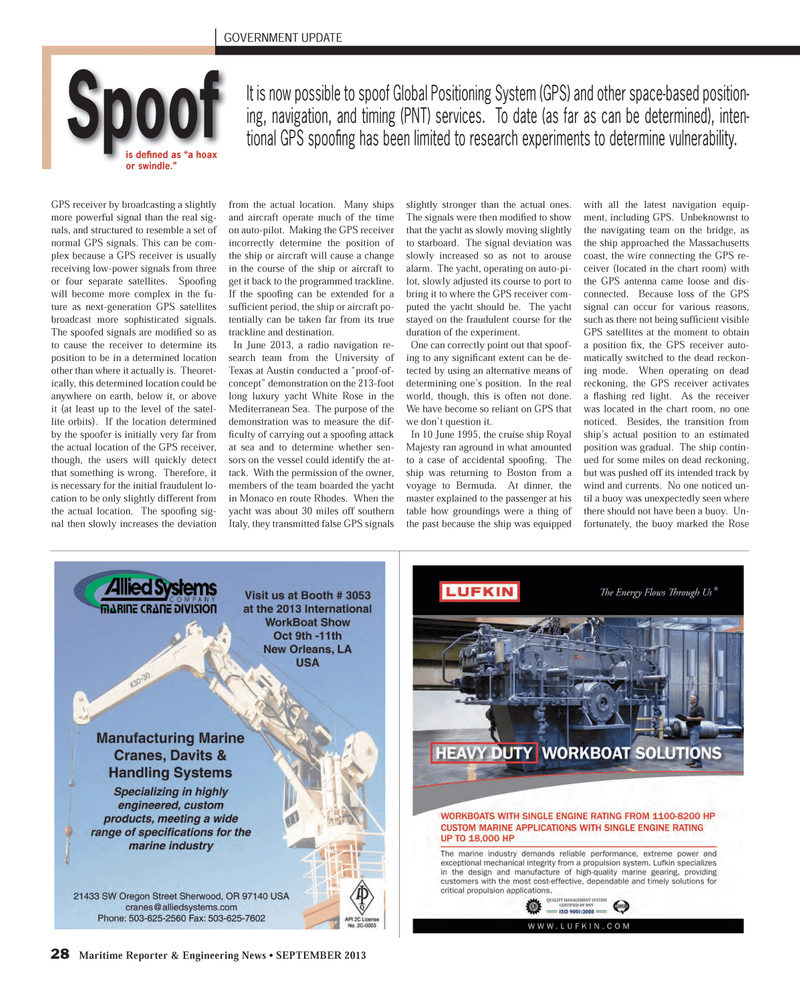
Page 28: of Maritime Reporter Magazine (September 2013)
Workboat Annual
Read this page in Pdf, Flash or Html5 edition of September 2013 Maritime Reporter Magazine
28 Maritime Reporter & Engineering News ? SEPTEMBER 2013 GPS receiver by broadcasting a slightly more powerful signal than the real sig-nals, and structured to resemble a set of normal GPS signals. This can be com- plex because a GPS receiver is usually receiving low-power signals from three or four separate satellites. SpooÞ ng will become more complex in the fu-ture as next-generation GPS satellites broadcast more sophisticated signals. The spoofed signals are modiÞ ed so as to cause the receiver to determine its position to be in a determined location other than where it actually is. Theoret- ically, this determined location could be anywhere on earth, below it, or above it (at least up to the level of the satel-lite orbits). If the location determined by the spoofer is initially very far from the actual location of the GPS receiver, though, the users will quickly detect that something is wrong. Therefore, it is necessary for the initial fraudulent lo-cation to be only slightly different from the actual location. The spoo Þ ng sig- nal then slowly increases the deviation from the actual location. Many ships and aircraft operate much of the time on auto-pilot. Making the GPS receiver incorrectly determine the position of the ship or aircraft will cause a change in the course of the ship or aircraft to get it back to the programmed trackline. If the spooÞ ng can be extended for a sufÞ cient period, the ship or aircraft po- tentially can be taken far from its true trackline and destination.In June 2013, a radio navigation re-search team from the University of Texas at Austin conducted a ?proof-of- concept? demonstration on the 213-foot long luxury yacht White Rose in the Mediterranean Sea. The purpose of the demonstration was to measure the dif-Þ culty of carrying out a spoo Þ ng attack at sea and to determine whether sen-sors on the vessel could identify the at-tack. With the permission of the owner, members of the team boarded the yacht in Monaco en route Rhodes. When the yacht was about 30 miles off southern Italy, they transmitted false GPS signals slightly stronger than the actual ones. The signals were then modiÞ ed to show that the yacht as slowly moving slightly to starboard. The signal deviation was slowly increased so as not to arouse alarm. The yacht, operating on auto-pi- lot, slowly adjusted its course to port to bring it to where the GPS receiver com-puted the yacht should be. The yacht stayed on the fraudulent course for the duration of the experiment. One can correctly point out that spoof-ing to any signiÞ cant extent can be de- tected by using an alternative means of determining one?s position. In the real world, though, this is often not done. We have become so reliant on GPS that we don?t question it. In 10 June 1995, the cruise ship Royal Majesty ran aground in what amounted to a case of accidental spooÞ ng. The ship was returning to Boston from a voyage to Bermuda. At dinner, the master explained to the passenger at his table how groundings were a thing of the past because the ship was equipped with all the latest navigation equip-ment, including GPS. Unbeknownst to the navigating team on the bridge, as the ship approached the Massachusetts coast, the wire connecting the GPS re-ceiver (located in the chart room) with the GPS antenna came loose and dis-connected. Because loss of the GPS signal can occur for various reasons, such as there not being sufÞ cient visible GPS satellites at the moment to obtain a position Þ x, the GPS receiver auto- matically switched to the dead reckon-ing mode. When operating on dead reckoning, the GPS receiver activates a ß ashing red light. As the receiver was located in the chart room, no one noticed. Besides, the transition from ship?s actual position to an estimated position was gradual. The ship contin- ued for some miles on dead reckoning, but was pushed off its intended track by wind and currents. No one noticed un-til a buoy was unexpectedly seen where there should not have been a buoy. Un- fortunately, the buoy marked the Rose GOVERNMENT UPDATE It is now possible to spoof Global Positioning System (GPS) and other space-based position-ing, navigation, and timing (PNT) services. To date (as far as can be determined), inten- tional GPS spooÞ ng has been limited to research experiments to determine vulnerability. Spoof is deÞ ned as Òa hoax or swindle.ÓMR #9 (26-33).indd 28MR #9 (26-33).indd 289/3/2013 10:11:44 AM9/3/2013 10:11:44 AM

 27
27

 29
29
